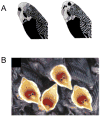A comparative view of face perception
- PMID: 20695655
- PMCID: PMC2998394
- DOI: 10.1037/a0019460
A comparative view of face perception
Abstract
Face perception serves as the basis for much of human social exchange. Diverse information can be extracted about an individual from a single glance at their face, including their identity, emotional state, and direction of attention. Neuropsychological and functional magnetic resonance imaging (fMRI) experiments reveal a complex network of specialized areas in the human brain supporting these face-reading skills. Here we consider the evolutionary roots of human face perception by exploring the manner in which different animal species view and respond to faces. We focus on behavioral experiments collected from both primates and nonprimates, assessing the types of information that animals are able to extract from the faces of their conspecifics, human experimenters, and natural predators. These experiments reveal that faces are an important category of visual stimuli for animals in all major vertebrate taxa, possibly reflecting the early emergence of neural specialization for faces in vertebrate evolution. At the same time, some aspects of facial perception are only evident in primates and a few other social mammals, and may therefore have evolved to suit the needs of complex social communication. Because the human brain likely utilizes both primitive and recently evolved neural specializations for the processing of faces, comparative studies may hold the key to understanding how these parallel circuits emerged during human evolution.
2010 APA, all rights reserved
Figures







References
-
- Adachi I, Fujita K. Cross-modal representation of human caretakers in squirrel monkeys. Behavioural Processes. 2007;74(1):27–32. - PubMed
-
- Adolphs R. Neural systems for recognizing emotion. Current Opinions in Neurobiology. 2002;12(2):169–177. - PubMed
-
- Adolphs R, Gosselin F, Buchanan TW, Tranel D, Schyns P, Damasio AR. A mechanism for impaired fear recognition after amygdala damage. Nature. 2005;433(7021):68–72. - PubMed
-
- Adolphs R, Tranel D, Damasio AR. The human amygdala in social judgment. Nature. 1998;393(6684):470–474. - PubMed
-
- Allison T, Puce A, McCarthy G. Social perception from visual cues: role of the STS region. Trends in Cognitive Sciences. 2000;4(7):267–278. - PubMed

